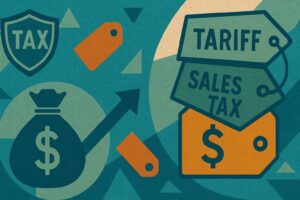Reading time: 5 minutes
Published: October 16, 2025
Ever noticed that imported items ring up at the register for more than you expected? You’re probably paying state and local sales tax on top of the tariff that was already baked into the price, literally a tax on a tax. Double taxation can also strike dividends and cross-border income, but on retail imports there’s almost no legal workaround; the cost simply flows through to consumers.
Note: Because tariffs are legally classified as customs duties, some experts insist they aren’t “taxes” in the formal sense. For consumers, though, the effect is identical: tariffs raise the price first, and sales tax is then calculated on that higher amount. So, we’ll treat them as a tax for practical purposes.

Key Takeaways
- Imported goods often face “tax-on-tax”: tariffs first, then sales tax on the tariff-inflated price.
- Dividends are taxed twice: once at the corporate level and again when paid to you.
- International earnings can be taxed by two countries, but treaties usually provide credits to offset one layer.
- Outside of treaty credits or specific exemptions (e.g., resale certificates), most double taxation on imports is unavoidable; your best defense is price comparison or choosing non-imported substitutes.
Understanding Double Taxation
Double taxation typically refers to income or goods being taxed twice. This can happen when two different tax jurisdictions, such as state and federal, both claim the right to tax the same income. A common example is when you pay income tax at both the state and federal levels. But it’s not just income that can get caught in the double taxation net; imported goods can also be subject to it.
Double Taxation on Imports
When it comes to imports, double taxation can sneak up on you. When tariffs raise the wholesale cost, the retailer passes that higher cost to you. Sales tax applies to the final retail price, tariff included, so you are effectively taxed twice.
Example: How “Tax on a Tax” Works at Today’s Rates
An importer buys a European-built car for $50,000:
- The tariff (15%) adds $7,500 (15% duty on EU autos and parts took effect August 1, 2025).
- The landed cost is $50,000 + $7,500 = $57,500
- The state and local sales tax (assume it’s 7.5 %) is applied to the tariff-inflated price: 7.5 % × $57,500 = $4,313
- The out-the-door price to the buyer is $57,500 + $4,313 = $61,813
Here’s the break-down of the extra cost created by the tariff:
- Tariff itself: $7,500
- Sales tax charged on the tariff (7.5 % × $7,500): $563
- Total “tax-on-tax” layer: $8,063
So even though the importer “only” pays a $7,500 duty, the consumer’s bill grows by roughly $8,063 once the compulsory sales tax levied on that duty is included.
Unless you qualify for a resale or manufacturing exemption, which most end-consumers don’t, there’s no legal way to carve the tariff out of the taxable base. See this technical brief for details. ↗
Double Taxation on Dividends
Investing in stocks can also lead to double taxation. When a corporation earns a profit, it pays corporate income tax. When the company pays a dividend, you usually owe a second layer of tax. Ordinary dividends are taxed at your regular income-tax rate, while qualified dividends benefit from the lower long-term capital-gains brackets, unless the shares are held in a tax-advantaged account such as a 401(k) or Roth IRA. This means the same money is taxed twice: first at the corporate level and then at the individual level.
International Double Taxation
If you’re working or investing abroad, you might encounter international double taxation. This occurs when two countries tax the same income. For instance, if you earn income in a foreign country, that country might tax your income, and then your home country might tax it again. Fortunately, many countries have tax treaties in place to prevent this. These treaties often allow for tax credits that can reduce the double taxation burden.
Can You Avoid It?
Business Importers: Resale certificates or “direct-pay” permits can remove the sales-tax layer, but only if you’re legally buying for resale or further manufacturing.
Imports: For ordinary consumers, no. Retailers must include the tariff in the taxable sales price, so you normally pay sales tax on the duty as well. The extra layer drops away only if the seller “eats” the duty or makes you the importer of record, but the tariff itself still gets paid either way.
Dividends: Holding stocks in a tax-advantaged account (Roth IRA, 401(k), HSA) prevents the second layer, at least until you withdraw the funds.
International Income: Claim the Foreign Tax Credit (Form 1116) or apply an applicable treaty.
Triple Taxation: When Double Isn’t Enough
In some rare cases, you might even face triple taxation. This can happen in complex investment scenarios where income is taxed at multiple levels, such as corporate, shareholder, and personal levels. It’s less common but worth being aware of if you’re involved in intricate investment structures. If you ever find yourself puzzled by the layers of taxation, remember that seeking advice from a tax professional can be invaluable.
True triple taxation is rare for individuals; it typically appears in tiered corporate structures. For example, when income flows from a foreign subsidiary to its U.S. parent and is then distributed to shareholders as dividends. This case is best handled with professional tax planning.
Conclusion
Double and even triple taxation are mostly structural and built into law rather than something you can out-smart at checkout. Understanding where they appear lets you budget realistically and take advantage of the few legitimate offsets that do exist, such as foreign tax credits or tax-sheltered accounts for dividends.